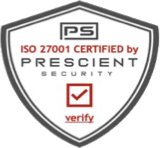Once upon a time, board members and executive managers treated cybersecurity and data security matters strictly as costs incurred by their respective businesses. Today, the cost of not investing in the proper technology and opening your organization to a potential data breach costs, on average, over $6 million.
It’s clear that, in today’s climate, data security must be integrated into an organization’s governance, risk management, and compliance (GRC) protocols. Proper investments into automated data reporting platforms can actually save organizations over $2.4 million over business entities that don’t make those investments.
So how do leaders integrate data security matters into GRC protocols? How do the cost benefits of making those investments reach the ears of key stakeholders in the businesses?
What is entity data management?
A common mistake when discussing technical concerns with executive stakeholders is to use a lot of technical jargon. While many points in those meetings are very valid, they confuse non-technically inclined entity managers. The concerns are buried under a number of confusing statements, and stakeholders lose interest in pursuing the matter.
Instead, try communicating the point using more simplistic language. First and foremost, define what exactly entity data management is to help the board understand why it matters.
Entity data management is a legal collection of the organization’s corporate records. Examples of this data include minute book documents, organizational charts, cap tables, compliance protocols, subsidiary reports, and so forth.
What is entity management software?
Once you’ve defined entity data management, you can explain entity management software and how it can benefit the business. Entity management software is an intuitive solution to provide cloud-based data security measures for all entity data concerns.
Entity management software like MinuteBox is backed by biometric and hardware key authentication solutions. These security measures provide additional protection to entity data, restricting access to only those stakeholders with approved authorization to view those protected corporate records. Effectively, entity management software becomes a single source of record for all corporate entity data.
The MinuteBox platform also contains a built-in compliance framework. This framework deploys automated prompts when compliance deadlines, date-based tasks, and any non-compliance error notifications are triggered by human error.
As a result, entity management software is more than just a secure method of hosting legal entity data. It also helps guide GRC protocols throughout the organization, protecting the business entity from the penalties of failed corporate governance and non-compliance.
Improve stakeholders’ familiarity with data security risks
Once you’ve briefed your stakeholders on the importance of entity data security, and the benefits of entity management software, you can explain how to improve security, visibility, and transparency around legal entity data.
Explain why you need both internal and external entity data security
Most board members and executive leaders assume that data security risks and breaches most commonly occur outside the bounds of the organization. In fact, 91% of successful cybersecurity and data security breaches originate from phishing email scams sent to internal corporate employees.
To remedy this challenge, create an educational seminar for all employees that explains the dangers of phishing email scams. Train your staff how to spot the signs of these dangerous emails so that they learn how to throw them in the trash.
Also, by investing in entity management software, all legal entity data is safely secure within the platform. Any requests for private corporate records from phishing emails remain empty requests because only a controlled group of stakeholders can access those records.
Remember to avoid using technical jargon when briefing stakeholders
A small percentage of board members and executive managers will have technical experience. The vast majority of stakeholders have a rudimentary understanding, but their knowledge is very limited. Therefore, speaking in technical terms is likely to result in glossed over eyes and misunderstood responses.
Cybersecurity and data security breaches are very serious. You just need to explain the severity of those matters using language those stakeholders will understand. Boil your explanations down to a matter of cost, and highlight the cost to the organization that will result from not investing in the right data security protocols.
Emphasize the value of entity management technology to reduce risk
Relitigate the benefits of entity management software and how the platform helps reduce risk of cybersecurity and data security breaches. Emphasize how all corporate entity records are securely managed within the platform, and remind stakeholders of the additional security measures that restrict access to only a handful of users.
Highlight the real risk of the problem, but then walk stakeholders through the proposed solution. By showcasing a concrete plan to address data security risks, you’ll secure buy-in from top management so that you can move forward with an implementation plan.
Ready to address data security risks head-on? Join the MinuteBox revolution and protect all legal entity data with advanced security measures that foster the well-being of your corporation.


